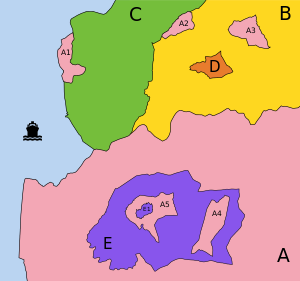
Back الحبيسة والمستحاطة Arabic Enclave y exclave AST ছিটমহল ও এক্সক্লেভ Bengali/Bangla Clofan ac allglofan CY Enklave og eksklave Danish Περίκλειστο και αποσπασμένο έδαφος Greek درونبوم و برونبوم FA Enclave et exclave French Iadhtag agus eilean-ranntair GD מובלעת HE
- A:
- possesses 5 exclaves (A1, A2, A3, A4, and A5): it is impossible to go from the main part of A to any of these parts going only through territory of A; however:
- A1 and A2 are not enclaves: neither of them is surrounded by a single "foreign" territory;
- A1 is a semi-enclave and a semi-exclave: it has an unsurrounded sea border;
- A2 is an exclave of A: it is separated from A;
- A3 is an enclave: it is totally surrounded by B;
- A4 and A5 are counter-enclaves (also known as second-order enclaves): territories belonging to A that are encroached inside the enclave E;
- contains 1 enclave (E): "foreign" territory totally surrounded by territory of A;
- contains 1 counter-counter-enclave, or third-order enclave (E1).
- possesses 5 exclaves (A1, A2, A3, A4, and A5): it is impossible to go from the main part of A to any of these parts going only through territory of A; however:
- B:
- contains 2 enclaves (A3 and D).
- C:
- continuous territory, contains no enclave or exclave
- D:
- is an enclaved territory: it is territorially continuous, but its territory is totally surrounded by a single "foreign" territory (B).
- E:
- is an enclaved territory: it is inside A;
- contains 2 enclaves (A4 and A5), which are counter-enclaves of A;
- possesses 1 counter-enclave (E1), which is a counter-counter-enclave as viewed by A and contained within A5.
An enclave is a territory that is entirely surrounded by the territory of only one other state or entity. Such territory can be a small territory as part of a larger one.[1] Enclaves may also exist within territorial waters.[2]: 60 Enclave is sometimes used improperly to denote a territory that is only partly surrounded by another state.[1] Many enclaves are also exclaves, but some are not, for example Vatican City and San Marino (both enclaved by Italy) and Lesotho (enclaved by South Africa) are completely enclaved sovereign states.
An exclave is a portion of a state or district geographically separated from the main part, by some surrounding alien territory (of one or more states, districts, etc.).[3] Many exclaves are also enclaves, but not all: an exclave surrounded by the territory of more than one state, is not enclave.[4] The Azerbaijani exclave of Nakhchivan is an example of an exclave that is not an enclave, as it borders Armenia, Turkey and Iran.
Semi-enclaves and semi-exclaves are areas that, except for possessing an unsurrounded sea border (a coastline contiguous with international waters), would otherwise be enclaves or exclaves.[4]: 116 [5]: 12–14 Semi-enclaves and enclaves are mutually exclusive. Likewise, semi-exclaves and exclaves are mutually exclusive. Enclaves and semi-enclaves can exist as independent states (Monaco, The Gambia and Brunei are semi-enclaves), while exclaves and semi-exclaves proper always constitute just a part of a sovereign state (like the Kaliningrad Oblast).[4]
A pene-exclave is a part of the territory of one country that can be conveniently approached—in particular, by wheeled traffic—only through the territory of another country.[6]: 283 Pene-exclaves are also called functional exclaves or practical exclaves.[5]: 31 Many pene-exclaves partially border their own territorial waters (i.e., they are not surrounded by other nations' territorial waters), such as Point Roberts, Washington, and Minnesota's Northwest Angle. A pene-exclave can also exist entirely on land, such as when intervening mountains render a territory inaccessible from other parts of a country except through alien territory. A commonly cited example is the Kleinwalsertal, a valley part of Vorarlberg, Austria, that is accessible only from Germany to the north.
| Enclave | Exclave | Semi-enclave | Semi-exclave | Both enclave and exclave | Enclave but not exclave | Exclave but not enclave | Both semi-enclave and semi-exclave | Semi-enclave but not semi-exclave | Semi-exclave but not semi-enclave | |
|---|---|---|---|---|---|---|---|---|---|---|
| Number of distinct alien territory[a] bordered | 1[b] | ≥1 | 1 | ≥1 | 1 | 1 | >1 | 1 | 1 | >1 |
| Belongs to a larger territory | Maybe | Yes | Maybe | Yes | Yes | No | Yes | Yes | No | Yes |
| Has unsurrounded sea border(s)[c] | No | No | Yes | Yes | No | No | No | Yes | Yes | Yes |
- ^ a b Raton, Pierre (1958). "Les enclaves". Annuaire Français de Droit International. 4: 186. doi:10.3406/afdi.1958.1373.
- ^ Cite error: The named reference
Melamidwas invoked but never defined (see the help page). - ^ "Exclave". Webster's Encyclopedic Unabridged Dictionary of the English Language. 1989. p. 497.
- ^ a b c Rozhkov-Yuryevsky, Yuri (2013). "The concepts of enclave and exclave and their use in the political and geographical characteristic of the Kaliningrad region". Baltic Region. 2 (2): 113–123. doi:10.5922/2079-8555-2013-2-11.
- ^ a b Cite error: The named reference
EVwas invoked but never defined (see the help page). - ^ Robinson, G. W. S. (September 1959). "Exclaves". Annals of the Association of American Geographers. 49 (3, [Part 1]): 283–295. doi:10.1111/j.1467-8306.1959.tb01614.x. JSTOR 2561461.
Cite error: There are <ref group=lower-alpha> tags or {{efn}} templates on this page, but the references will not show without a {{reflist|group=lower-alpha}} template or {{notelist}} template (see the help page).
